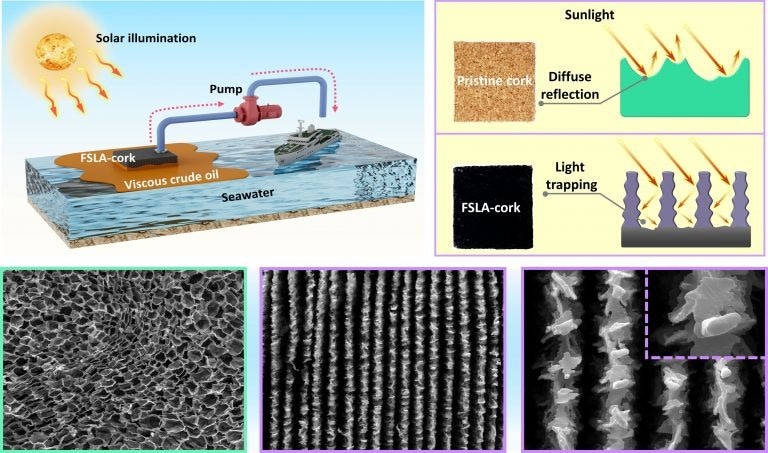Reviewed by Lexie CornerApr 24 2024
In a study published in Applied Physics Letters, published by AIP Publishing, researchers from Central South University, Huazhong University of Science and Technology, and Ben-Gurion University of the Negev describe how they utilized laser treatments to turn ordinary cork into an effective tool for cleaning oil spills.
 To remove oil from water, the authors used cork treated by a fast-pulsing laser method that removes some oxygen from the material, increasing the relative carbon and making it more water-repelling and oil-attracting. Laser treatment also alters the structure of the cork: When viewed at the nanoscopic level, the material has deep grooves, which increase the total surface area of the cork and allow it to trap sunlight and warm the oil, making the oil easier to collect. Image Credit: Yuchun He
To remove oil from water, the authors used cork treated by a fast-pulsing laser method that removes some oxygen from the material, increasing the relative carbon and making it more water-repelling and oil-attracting. Laser treatment also alters the structure of the cork: When viewed at the nanoscopic level, the material has deep grooves, which increase the total surface area of the cork and allow it to trap sunlight and warm the oil, making the oil easier to collect. Image Credit: Yuchun He
Oil spills severely harm ocean habitats. They can damage coral reefs, coastal forests, and adjacent land, and their effects on fish and marine animals can continue for decades. Oil is frequently broken down using chemical dispersants, although doing so often makes the oil more harmful.
The researchers hoped to develop a harmless, effective oil cleanup solution using low-carbon materials, but an unexpected discovery influenced their choice of cork.
In a different laser experiment, we accidentally found that the wettability of the cork processed using a laser changed significantly, gaining superhydrophobic (water-repelling) and superoleophilic (oil-attracting) properties. After appropriately adjusting the processing parameters, the surface of the cork became very dark, which made us realize that it might be an excellent material for photothermal conversion.
Yuchun He, Study Author and Professor, Central South University
Kai Yin, another study author, added, “Combining these results with the eco-friendly, recyclable advantages of cork, we thought of using it for marine oil spill cleanup. To our knowledge, no one else has tried using cork for cleaning up marine oil spills.”
Cork is derived from the bark of cork oak trees, which can survive hundreds of years. These trees can be harvested every seven years, making cork a renewable resource. When the bark is removed, the trees increase their biological activity to replace it and store more carbon; therefore, harvesting cork helps to reduce carbon emissions.
The scientists experimented with many types of fast-pulsing laser treatment to find the best balance of qualities in the cork at the lowest possible cost. To determine the material’s durability after multiple cycles of warming and cooling, they closely examined nanoscopic structural changes, measured the ratio of oxygen and carbon in the material, changed the angles with which water and oil contact the surface, and measured the material's light wave absorption, reflection, and emission across the spectrum.
Cork’s photothermal characteristics are enhanced via laser processing, allowing it to warm up fast under the sun. The deep grooves also enhance the surface area exposed to sunlight, allowing a small amount of sunlight to warm the cork in 10-15 seconds. This energy is utilized to heat spilled oil, which reduces its viscosity and makes it simpler to collect. In testing, the laser-treated cork extracted oil from water in 2 minutes.
The laser treatments not only improve oil absorption but also aid in keeping water out.
Yin added, “When the cork undergoes a fast-pulsing laser treatment, its surface microstructure becomes rougher. This micro- to nano-level roughness enhances hydrophobicity.”
As a result, the cork accumulates oil without absorbing water, allowing the oil to be removed from the cork and perhaps reused.
He concluded, “Oil recovery is a complex and systematic task, and participating in oil recovery throughout its entire life cycle is our goal. The next step is to prepare electrothermal materials using polyurethane foam as the skeleton for oil adsorption, combining photothermal and electrothermal techniques to form an all-weather oil recovery system.”
Journal Reference:
He, Y., et al., (2024) Femtosecond laser structured black superhydrophobic cork for efficient solar-driven cleanup of crude oil. Applied Physics Letters.doi.org/10.1063/5.0199291